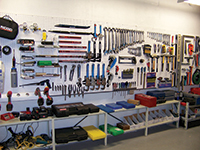Last week I blogged about the challenge of revolutionising the productivity of the knowledge worker, which Peter Drucker set for us. We looked at the division of knowledge labour, the automation/augmentation of knowledge work, and the knowledge supply chain. Now we look at the lean knowledge working environment.
 |
| The lean working environment for the manual worker (image from greenhousecanada.com). Does the working environment for the knowledge worker look like this? |
Many organisations are now beginning to realise the importance of the correct knowledge reaches each knowledge worker, at the time and place they need it, to the required standard and quality, in a deliberate and systematic manner. However our track record of delivering that knowledge in a lean and efficient way is poor, and there is little or no sign of a relentless focus on removing waste and adding value.
Knowledge bases are full and clumsy to use, poorly structured and indexed, with duplicate, outdated or irrelevant material. Knowledge workers are often required to use multiple search engines or to visit multiple sites, social media streams are unfiltered and full of noise, knowledge is unsynthesised, often unfindable, and usually is poorly tagged and labelled.
All of this makes knowledge seeking a massive chore, which it is easier to skip than undertake.
A lean approach to Knowledge Management would involve eliminating the 7 wastes, such as
- Over-production of knowledge, which then becomes noise in the system
- Waiting for knowledge, and a slow turnover speed of knowledge
- Unnecessary hand-off of knowledge, with unnecessary steps in the chain between knowledge supplier and knowledge user
- Non-value added processing—doing more work than is necessary. We often see this in lesson-learning systems, where the work of sifting, sorting and synthesising multiple lessons or multiple search-hits has to be done by the knowledge user.
- Unnecessary "motion" - the need to visit multiple databases, multiple knowledge bases, a separate CoP system etc
- Excess knowledge inventory— frequently resulting from overproduction.
- Defective knowledge.
Lean KM is the last of the four components to drive knowledge worker productivity. Together they can be revolutionary.
If we can have a lean and efficient knowledge supply chain, using automation and augmentation to deliver high quality knowledge to knowledge workers in a divided system of knowledge work, then we will approach Peter Drucker's initial vision of a 50-fold increase in productivity of the knowledge workers.
If we can have a lean and efficient knowledge supply chain, using automation and augmentation to deliver high quality knowledge to knowledge workers in a divided system of knowledge work, then we will approach Peter Drucker's initial vision of a 50-fold increase in productivity of the knowledge workers.




No comments:
Post a Comment